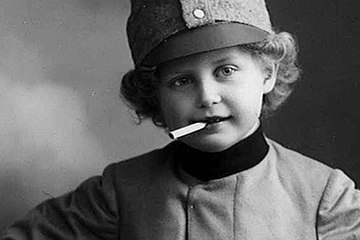During the First World War, the mental mobilisation of the population reached an unprecedented level. Propagandist actions included the production and distribution of sound recordings broadcasting the encouraging words of the emperor and leading generals in the Imperial-Royal Army.
Thomas Alva Edison’s invention of the phonograph in 1877 made it possible for the first time to record sounds on a cylinder covered with tin foil and then play them through a funnel-shaped horn. Ten years later Alexander Graham Bell and Charles Sumner Tainter brought the graphophone onto the market, which, as a further development of the phonograph, could already play recordings lasting four minutes. Simultaneously Emile Berliner developed the gramophone and the record disc, which was at first made of hard rubber and could play for ninety seconds. From 1897 onwards, shellac was used as substrate material for the discs, which soon surpassed phonograph cylinders in significance. The first shellac records had a playing time of four minutes, but this was doubled in 1904 with the introduction of double-sided discs.
This relatively new medium was exploited as well in the First World War, and records were produced playing speeches by political and military leaders. The Österreichische Mediathek owns a series of eight 78-rpm shellac discs sized 30 cm made by Lindström and commissioned by the k. k. Österreichischen Militär-, Witwen- und Waisenfonds (Imperial-Royal Austrian Military, Widows’ and Orphans’ Fund); their sale was to benefit those left bereft by the war and war victims. The recordings include short statements by the emperor, the Austrian heir apparent, and Chief of General Staff Freiherr (Baron) Conrad von Hötzendorf.
Many parts of the Austrian-Hungarian population had never before heard the voice of the emperor. With the speech recorded on disc on 14 December 1915 in which Franz Joseph expressed his heartfelt wishes to the k. k. Österreichischen Militär- Witwen- und Waisenfonds, the Kaiser was made acoustically present for all those who until then had known him merely from pictures. To quote the speech: “Ich begleite das Wirken des Österreichischen Militär- Witwen-, und Waisenfonds mit meinen herzlichsten Wünschen. Möge seinen edlen Bestrebungen zum Wohle der Hinterbliebenen meiner braven Krieger voller Erfolg beschieden werden.” (“I support the work of the des Österreichischen Militär- Witwen-, und Waisenfonds with my most heartfelt wishes. May its noble endeavours for the well-being of the bereaved of my brave soldiers be most successful”). The Österreichische Mediathek in all owns three sound recordings of Emperor Franz Joseph, the first made already in 1901, and the second two years later in Bad Ischl for the phonogram archive of the Austrian Academy of Sciences. The December 1915 recording is the emperor’s only vocal portrait that was accessible to the population. The following information was written on the prestigious, art nouveau- inspired record cover: “Vorliegende Platte ist das einzige Stimmporträt Seiner kaiserlichen und königlichen apost. Majestät, welches der Öffentlichkeit übergeben wurde” (“This record disc is the only vocal portrait of His Imperial and Royal Apostolic Majesty ever to be made accessible to the public”).
Translation: Abigail Prohaska
Rühr, Sandra: Tondokumente von der Walze zum Hörbuch. Geschichte – Medienspezifik – Rezeption, Göttingen 2008
Alle Informationen zu den im Besitz der Mediathek befindlichen Tondokumenten entstammen der Website der Österreichischen Mediathek.
http://www.mediathek.at/virtuelles-museum/kriegstoene/cid/5393 (22.03.2014)
-
Chapters
- Propaganda: psychological warfare in the First World War
- The battle for hearts and minds.
- Friend and foe – guilt and innocence in First World War propaganda
- “Let your hearts beat for God and your fists beat the enemy”
- The First World War as reflected in the distortions of caricature
- The war on the wall
- Truth from the clouds
- The Emperor’s Voice
- Tones and Sounds







